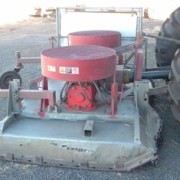Weed control options
June 11th, 2014
 Preventing weed seed spread is one of the most effective forms of weed control. However, once an infestation has become established on your property, you’ve got a number of control options…
Preventing weed seed spread is one of the most effective forms of weed control. However, once an infestation has become established on your property, you’ve got a number of control options…
The best results are generally achieved by employing integrated weed management. This should be used in conjunction with a carefully considered management plan with regular monitoring and follow-up control.
Some of the common control options include:
Physical demarcation and signage
Access to weed infested areas should be excluded where possible until treatment/removal is complete. If the area is subject to regular movements, the area should be adequately posted at entry and exit routes to ensure people are aware of the risks and any management requirements. Signpost no-go zones where appropriate and consider fencing areas off if there is a high risk of contamination (i.e. isolated infestation of seeding parthenium weed or intensive rehabilitation site).
Physical hand removal
Hand removal can be a viable option for small infestations. However, it is generally not recommended in the majority of situations due to the high risk of spread, seed bank disturbance and disposal issues. Consider timing treatment immediately following rainfall events and ensure that plant reproductive materials are not accidentally released during collection, storage and disposal.
Mechanical (grubbing, slashing or removal)
Mechanical removal should only be considered where there is an urgent need to access an area (e.g. where chemical control measures are not an option due to tight clearing schedules). Mechanical options are good at removing the biomass of the weed however they can disturb the soil, creating an ideal environment for further weed growth or erosion. To ensure that regrowth is identified and appropriately managed, follow-up chemical treatment and long term monitoring is required. Slashing of grasses and broadleaf annuals can be carried out over winter months or drought periods, particularly along access tracks. To minimise the risk of weed seed spread, consider hygiene measures such as slasher blowers or brushing off the slasher immediately after coming into contact with pest grasses.
Biological controls
In some situations and locations, biological controls can be used to manage specific weed species. Some of the more common biological controls include rust for Noogoora burr, leaf-mining fly for lantana, cochineal and cactoblastis for prickly pear and tree pear, thrips for mother of millions and salvinia weevil for salvinia. Biological controls are generally considered in situations where the weed threat is low and where conventional control measures are considered impractical.
Biological controls are designed to be host-specific and can be shifted by collecting an infested segment of plant and transferring it to an infestation where the biological control is not currently active. All biological controls should be carefully monitored to ensure establishment and effectiveness. Contact your local Council or Department of Agriculture, Fisheries and Forestry (DAFF) office for further information on locally available biocontrols.
Chemical treatment
Chemical treatment can provide a relatively fast and cost effective control option. However, chemical treatment should only be undertaken by licenced operators who hold a commercial operators licence for Ground Distribution (or under their direct supervision of a licence holder). All spraying should be conducted in accordance with the chemical label, manufacturer’s instructions and Material Safety Data Sheet (MSDS). Where possible, registered residual herbicides are recommended to provide long term control, however this will depend on the land use and terrain. To ensure livestock crops are not affected, carefully check all instructions including the withholding periods.
Fire
Controlled burns may be considered useful for managing grasses, woody and perennial weeds (such as mother of millions, rubber vine and lantana etc). Controlled burns should only be considered when the conditions prevail for slower hot fires to cook the bases of the weed species and kill off the parent plants. Ensure permits are in place for controlled burns and that firebreaks and adequate fire fighting resources are in place. Fire can exacerbate some infestations and should be used with caution.
Grazing
High intensity grazing of grasses for short periods can be useful to break down biomass. It may also be encouraged for regeneration of natural grasses using hay as a mulch. Ensure livestock are free of weeds prior to movement between paddocks.
What weed control options do you use? Are you making the most of integrated weed management?